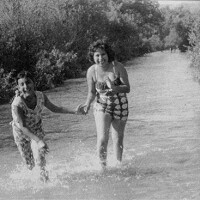What is a Watershed Anyway?

Chances are, on a day-to-day basis you give no thought to the Los Angeles River -- and I wouldn't be surprised. Every day, we probably get to our places of work through paved roadways, slip into our cubicles tucked inside glittering high-rise buildings, and lose ourselves in our computers. Nothing about our daily commute reminds us of the river, except perhaps the bright blue signs announcing "Los Angeles River," featuring the county's heron logo.
More on living by rivers
When I first starting writing about the river, I had a fascination for it, but I confess, had little understanding of its inner workings. For me, the river was like a mythological creature, a powerful symbol that binds Los Angeles County together, but not quite a physical reality that affects my everyday life.
I had kayaked along the river during last summer's experimental program, but that experience stayed in the realm of the novel. The river had yet to hit home. After little more than a month of covering stories and projects around the Los Angeles River however, that is beginning to change.
While interviewing experts and activists working in and around the river, I began to understand one little known truth that undergirds their work: that we all live by the water.
Not you, you say? I beg to differ. Even though we hardly see a trickle of water around our neighborhoods, that doesn't mean we don't affect the ecology of a river somewhere nearby. Here's why.
In each of my interviews, the term "watershed" kept popping up. While the dictionary rather dryly says a "watershed" is a "ridge that divides two drainage areas," what it fails to mention is how large one watershed can actually be. The Los Angeles River watershed covers about 834 square miles of land. It engulfs a large swath of Los Angeles, including all of San Fernando Valley, the western part of San Gabriel Valley, and much of Los Angeles. (Here's what the big picture in Los Angeles looks like.) Each watershed drains to a body of water, eventually making its way to the ocean.
Two of my favorite metaphors are those offered by urban activist Joe Linton in his book, "Down by the Los Angeles River." "It's kind of like a bathtub -- no matter where you put water in it, the water will all drain down to that one little hole. No matter where rain falls in a watershed, that rain will drain down to that watershed's river." Or, more poetically, he writes further on, "A watershed is like a whole leaf, the veins of the leaf are the creeks, and the stem is the river." In short, we are all part of one whole system.

When rain falls, it either soaks into the soil and makes its way to our groundwater, gets absorbed by plants, evaporates, or tumbles down to the nearest waterway. That may seem all well and good, until you consider the urban context. Full of impervious surfaces like paved roads, the city becomes an ever-dirty catchall that collects everything we put out -- oil and grease from our cars, pesticides from our lawns, litter from the streets -- to create the dirty concoction we call urban runoff, which eventually pollutes our waters.
A recent National Water Quality Inventoryreport found that urban runoff is the top reason for deteriorating water quality in surveyed estuaries and the third-largest source of deterioration in surveyed lakes. They also found that a normal city block generates five times the urban runoff as a woodland area of the same size.
"The river is really just the expression of the watershed, it's the main artery," said Melanie Winter, founder of The River Project. "But you don't have just a main artery, you have lots of smaller arteries and veins leading into it. That's where everything is happening. If you test the water quality in the river, you're picking up pollutants from all over the place. If you're looking at the river in a heavy rainstorm and you've got lots of volumes of water moving through there very quickly, that water is not just coming from the local neighborhood, it's coming from all over the area."
That's why no Los Angeles river project is ever complete without a stormwater capture and infiltration component. Tangentially, it also explained why I saw so many supermarket carts stuck in the Los Angeles River during my kayak ride on the river last year despite the fact that no supermarkets were in sight. Many residents take the carts to help them lug their groceries, then leave them by the roadside once they're done. With nothing to anchor them, the carts easily make their way down to the waterway, unless somehow the big box retailer collects them. The same scenario follows for everything we put out on our streets. It all finds its way to the river.
Seeing the watershed for what it is -- a large landform that affects the character of our water -- is what led Winter to focus her efforts on the Tujunga-Pacoima watershed, the largest subwatershed of the Los Angeles River at 225 square miles. "If you want to change the channel at all, you have to work away from the river. You have to work out in the watershed. You cannot cannot change the river by simply working on the river," said Winter.
She's not alone -- the Council for Watershed Health also uses this watershed approach, a holistic system of thinking about water. Not only are these -- and a growing number of organizations -- looking at just one small piece of the puzzle, they're quite literally looking at the bigger picture. I think it's time we regular Joes do too. Even if it just begins by putting supermarket carts right back where they belong.
Find your watershed by entering your ZIP. The EPA has also published a few tips to get you started on your watershed.



